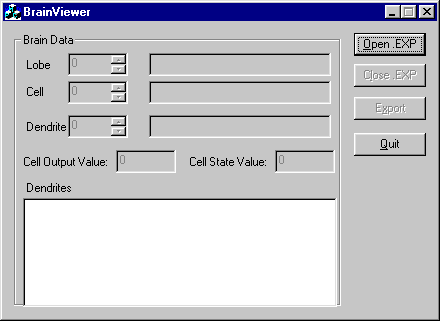
The BrainViewer program shows the current state of a Creatures 1 Norn brain. It works on an exported Norn (the .EXP file), decodes the saved brain information and provides the ability to browse through the cell and dendrite information.
Currently it is at Version 1.0 and is a bit rough around the edges (user interface wise) but I'm releasing it now as it is quite useable and I'd like to get feedback. Now that it is in a useable state I can update some of the information on the Brain Lobe page based upon results from this program.
The data displayed for the dendrites is based upon observation and 'best guess' on my part so if you find any errors or work out correct values please let me know. In particular the 'Cell' and (X,Y) values of the dendrites don't always match up and I haven't yet worked out why.
When you first run the program you'll get the following screen:

Press the Open Exp button and select an exported norn (*.EXP) file using the dialog presented. Once the file is selected it will be scanned for Brain information and you will be returned to the above screen with the ability to browse the information.
The screen shot below shows a norn loaded with the Weed cell of the Attention lobe displayed:
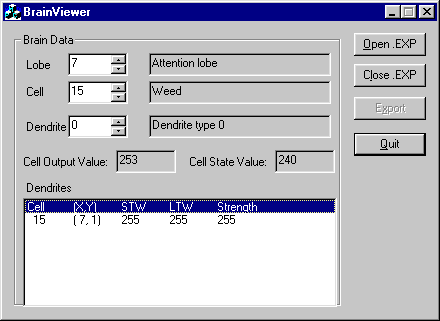
Notice that the 'Cell Output Value' and the 'Cell State Value' have values. This indicates that the norn was looking at a weed before it was exported. We know this because the Attention lobe is a Winner-takes-all lobe and the only cell with a value will be the object the norn is paying attention to.
In the 'Dendrites' list there is one dendrite shown. BrainViewer does not currently show what the source lobe is for this dendrite but we can tell from the genetics kit that the type 0 dendrites for the Attention lobe are sourced from the Stim/Source lobe (lobe number 2).
The 'Cell' column is the cell in the source lobe that this dendrite receives information from - It is Cell 15 which is the 'Weed' cell in the Stim/Source lobe. The (X,Y) mapping is the grid coordinate inside the source node where this cell is (Adding the (X, Y) offset given above to the (X,Y) offset of the Stim/Source lobe gives us (22,25) which is the cell location within the brain grid that this dendrite connects to). The main information here though is the Cell number from the source lobe.
The Short Term Weight, Long Term Weight and Strength of the dendrite are also shown. See the Brain Lobe information page for details on these.
Let's take a look at a more complicated Lobe. The following screen shot shows the decision lobe cell for the 'Push' decision:
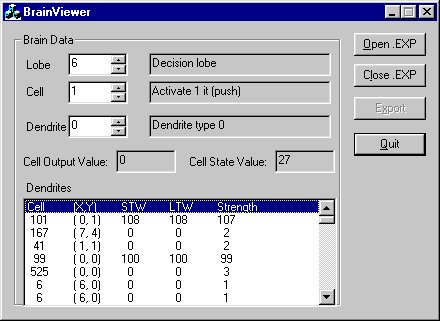
Type 0 dendrites are being displayed which are those corresponding to decisions that the norn knows are 'good' or reward giving. The Type 1 dendrites in this lobe represent decisions the norn knows are 'bad' or punishment inducing.
There are 128 dendrites to each cell in the decision lobe. I'll show how the mapping works from decision to concept to perception to give you an idea of the power of BrainViewer.
From the genetics kit we know that the source lobe for dendrite type 0 in the Decision Lobe is the Concept Lobe. The details displayed above are an example of where the 'Cell' and (X,Y) values don't appear to match up (ie. (0,1) is not cell number 101 of the concept lobe).
I'll do some experiments to work out which value is the correct one to use for the following illustration but for now we'll use the dendrite marked as cell '167 (7,4)' as these two numbers do match up (The width of the concept lobe is 40 and 4 * 40 + 7 = 167). This dendrite appears to be connected to cell 167 of the concept lobe.
Let's look at Cell 167 of the concept lobe:
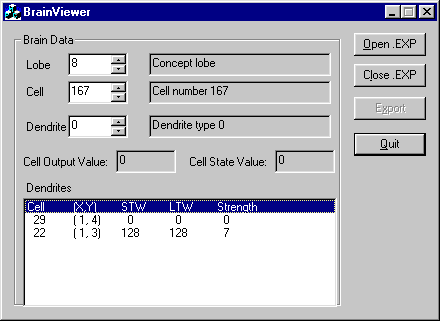
From the genetics kit we know that the type 0 dendrites from the concept lobe are sourced from the perception lobe. There are two dendrites related to the concept associated with cell 167 of this lobe. They come from cell 29 and cell 22 of the perception lobe. Using the information from the perception tutorial we can tell that this relates to cells 6 and cell 13 of the verb lobe. This is verb 'Get' and 'unallocated verb number 13'.
All this information together tells us that one of the concepts that contributes towards a norn wanting to 'push' something is related to rewards received when hearing verb 'get' and 'verb13'. As 'verb13' is not allocated this concept will never get strengthened and the dendrites will eventually migrate (notice the strength of the dendrite of 'verb13' above is 0 - it's about to migrate).
One more example. The following screen shot shows the decision lobe again with 'type 1' dendrites displayed for the 'push' action. These are the dendrites associated with punishment. The concepts they connect to effectively say 'if this concept is active I am less likely to push something'.
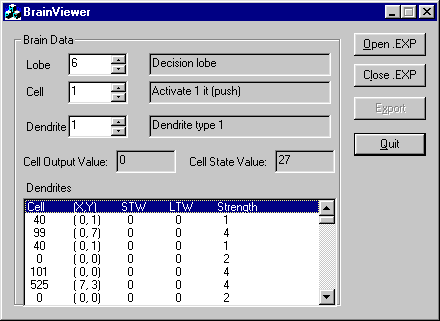
Choosing the first dendrite (Cell 40) we next go to the concept lobe to see what Cell 40 shows (remembering to change the dendrite type back to 0 when we switch lobes):
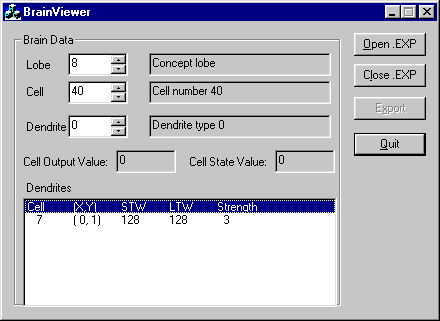
There is only one dendrite attached to this concept back to the perception lobe. Cell 7 of the perception lobe maps to cell 7 of the drive lobe which is 'lonely'. So concept cell 40 is the concept of loneliness. The norn is less likely to 'push' something if loneliness is high.
As you can see being able to view the structure of the brain gives us a lot of information about the Norn that just a genetic view does not. If you have a norn that behaves erratically you can use BrainViewer to try and work out what is wrong with the norn inside it's brain. It's also a useful tool for people who are creating new and advanced brain lobes.